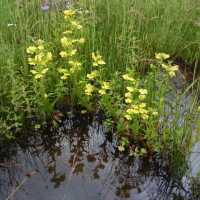Stems erect (rarely reclining), usually branching proximally, 2.5-10 dm, glabrous; rhizomes thickened; bulblets absent. Leaves opposite (distal sometimes whorled); petiole (0.2-)0.6-4 cm, ciliate proximally, cilia 0.2-1 mm; blade elliptic-lanceolate to lanceolate or linear-lanceolate (sometimes ± folded along midvein), 2-18 × 0.5-3 cm, base rounded to cuneate, decurrent, margins entire, plane, eciliolate or ciliolate proximally, apex acute to acuminate, surfaces not punctate (sometimes with small dark pits, especially apically, but these are not the resinous streaks referred to here as punctations), glabrous; venation pinnate-arcuate to obscurely pinnate to apparently single-veined (lateral veins obscure), often on same plant. Inflorescences axillary in distal leaves, solitary flowers (rarely verticils). Pedicels 1-4.2 cm, glabrous to stipitate-glandular. Flowers: sepals 5, calyx not streaked, 4-8 mm, glabrous, lobes broadly lanceolate to ovate, margins thin; petals 5, corolla yellow, not streaked, rotate, 5-12 mm, lobes with margins sometimes slightly erose distally, apex apiculate, stipitate-glandular adaxially; filaments distinct or nearly so, shorter than corolla; staminodes 0.5-1.7 mm. Capsules 4-6.5 mm, not punctate or only slightly reddish-punctate, glabrous. 2n = 34.
Flowering late summer-fall. Marshes, wet meadows, wet depressions, hammocks, swamps, stream banks; 40-2300 m; Alta., Man., N.B., Ont., Que., Sask.; Ala., Ariz., Ark., Conn., Del., D.C., Fla., Ga., Ill., Ind., Iowa, Kans., Ky., Maine, Md., Mass., Mich., Minn., Miss., Mo., Nebr., N.H., N.J., N.Mex., N.Y., N.C., N.Dak., Okla., Pa., R.I., S.C., S.Dak., Tenn., Vt., Va., Wash., W.Va., Wis.
Plant: Perennial herb; 3-12 dm tall, upright stems
Leaves: cauline, opposite, glabrous; 5-15 cm long, the petiole obscurely to slightly ciliate; blade ovate to lanceolate
INFLORESCENCE: a single peduncled flower in the axils of leaves
Flowers: yellow; calyx 4-8 mm long; corolla 5-10.5 mm long, stamens 5; 5 staminodia (anther-less appendages generally attached to the corolla and alternate with the stamens) present; ovary superior
Fruit: FRUITS valvate
Misc: Moist meadows, streambanks; 1500-2300 m (5000-7500 ft); Jul-Sep
REFERENCES: Cholewa Anita F. 1992. Primulaceae. Ariz.-Nev. Acad. Sci. 26(1)2.
REFERENCES: Cholewa Anita F. 1992. Primulaceae. Ariz.-Nev. Acad. Sci. 26(1)2.
Infrequent to rare in the bottoms of ditches, in ponds and swamps, and on the muddy borders of sloughs and streams.
General: Perennial, 10-130 cm tall; stems erect, sometimes decumbent at the base, simple to branched; rhizomatous.
Leaves: Cauline (lower blades withered by time of flowering), opposite, ovate to lanceolate, 5-15 cm long, 2-5 cm wide, glabrous, margins entire, base wedge-shaped, obtuse, or rounded, apex acute to acuminate; petiole 0.6-2.5 cm long, obscurely to slightly ciliate.
Flowers: Inflorescence an umbel, 3-5 flowered, glabrous to sparsely glandular-pubescent; pedicels 1-3.3 cm long, recurved near the apex in flower, becoming elongate and straight in fruit; calyx 5-10 mm long, lobes 4, lanceolate; corolla 10-20 mm long, lobes 4, strongly reflexed, maroon ring at point of reflex, followed by a broad band of yellow, the lobes lavender to purple; stamens with connate filaments, exposed beyond the corolla for 0.2-1.2 mm; flowers April-September.
Fruits: Capsule, broadly ovoid to nearly globose, 4-5.5 mm in diameter, 5-valved; seeds few to many.
Ecology: Moist meadows, streambanks, lake margins, and other wetland habitats; 1500-2400 m (5000-8000 ft); Apache, Coconino, Gila, Greenlee, and Navajo counties; Canada, eastern to central U.S., northwestern and southwestern U.S.
Notes: na
Editor: Springer et al. 2008
Erect from a short, stout, freely rooting rhizome, to 1 m, the lateral branches usually numerous and exceeding the subtending lvs; principal lvs lance-linear to narrowly oblong or lance-ovate, 4-10 נ1-2 cm, flat, green beneath, tapering or more rounded to the base, the petiole ciliate mainly below the middle, sometimes with a few scattered cilia distally; cal-lobes thin, 4-8 mm, the midnerve and usually also the 2 or 4 lateral ones visible under a hand-lens; cor-lobes 6-10 נ4-10 mm; stamens distinct; staminodes triangular-ovate to subulate; fr 4-6.5 mm thick; 2n=34. Sloughs, wet woods, and wet prairies; Me. and s. Que. to Fla., irregularly w. to Alta., Wash., and Ariz., commonest along the Atlantic seaboard from Me. to Md., and in the upper Miss. Valley. Late June-Aug. (Steironema h.)
Gleason, Henry A. & Cronquist, Arthur J. 1991. Manual of vascular plants of northeastern United States and adjacent Canada. lxxv + 910 pp.
©The New York Botanical Garden. All rights reserved. Used by permission.





